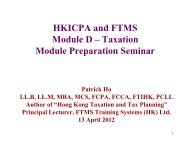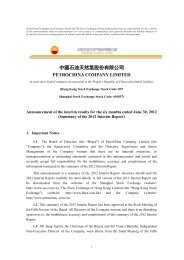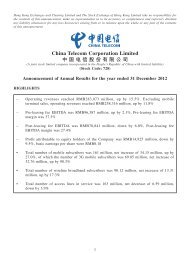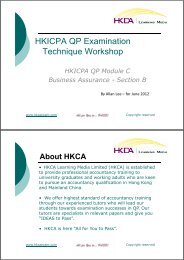1 HKAS 8 Accounting Policies, Changes in Accounting Estimates ...
1 HKAS 8 Accounting Policies, Changes in Accounting Estimates ...
1 HKAS 8 Accounting Policies, Changes in Accounting Estimates ...
Create successful ePaper yourself
Turn your PDF publications into a flip-book with our unique Google optimized e-Paper software.
<strong>HKAS</strong> 8.4<br />
<strong>HKAS</strong> 8.5<br />
22: <strong>Account<strong>in</strong>g</strong> policies, changes <strong>in</strong> account<strong>in</strong>g estimates and errors; events after the report<strong>in</strong>g period<br />
| Part C <strong>Account<strong>in</strong>g</strong> for bus<strong>in</strong>ess transactions<br />
1 <strong>HKAS</strong> 8 <strong>Account<strong>in</strong>g</strong> <strong>Policies</strong>, <strong>Changes</strong> <strong>in</strong> <strong>Account<strong>in</strong>g</strong><br />
<strong>Estimates</strong> and Errors<br />
Topic highlights<br />
<strong>HKAS</strong> 8 deals with the treatment of changes <strong>in</strong> account<strong>in</strong>g estimates, changes <strong>in</strong> account<strong>in</strong>g<br />
policies and errors.<br />
1.1 Objective<br />
The objective of <strong>HKAS</strong> 8 is to prescribe:<br />
The criteria for select<strong>in</strong>g and chang<strong>in</strong>g account<strong>in</strong>g policies<br />
The account<strong>in</strong>g treatment and disclosure of:<br />
– changes <strong>in</strong> account<strong>in</strong>g policies,<br />
– changes <strong>in</strong> account<strong>in</strong>g estimates, and<br />
– corrections of errors.<br />
The standard is <strong>in</strong>tended to enhance the relevance and reliability of an entity’s f<strong>in</strong>ancial statements,<br />
and the comparability of those f<strong>in</strong>ancial statements over time and with the f<strong>in</strong>ancial statements of<br />
other entities.<br />
The standard was extensively revised <strong>in</strong> October 2008. The new title reflects the fact that the<br />
material on determ<strong>in</strong><strong>in</strong>g profit or loss for the period has been transferred to <strong>HKAS</strong> 1.<br />
1.2 Def<strong>in</strong>itions<br />
The follow<strong>in</strong>g def<strong>in</strong>itions are given <strong>in</strong> the standard.<br />
Key terms<br />
<strong>Account<strong>in</strong>g</strong> policies are the specific pr<strong>in</strong>ciples, bases, conventions, rules and practices<br />
adopted by an entity <strong>in</strong> prepar<strong>in</strong>g and present<strong>in</strong>g f<strong>in</strong>ancial statements.<br />
A change <strong>in</strong> account<strong>in</strong>g estimate is an adjustment of the carry<strong>in</strong>g amount of an asset or a<br />
liability, or the amount of the periodic consumption of an asset, that results from the<br />
assessment of the present status of, and expected future benefits and obligations<br />
associated with, assets and liabilities. <strong>Changes</strong> <strong>in</strong> account<strong>in</strong>g estimates result from new<br />
<strong>in</strong>formation or new developments and, accord<strong>in</strong>gly, are not corrections of errors.<br />
Material. Omissions or misstatements of items are material if they could, <strong>in</strong>dividually or<br />
collectively, <strong>in</strong>fluence the economic decisions that users make on the basis of the f<strong>in</strong>ancial<br />
statements. Materiality depends on the size and nature of the omission or misstatement<br />
judged <strong>in</strong> the surround<strong>in</strong>g circumstances. The size or nature of the item, or a comb<strong>in</strong>ation<br />
of both, could be the determ<strong>in</strong><strong>in</strong>g factor.<br />
Prior period errors are omissions from, and misstatements <strong>in</strong>, the entity's f<strong>in</strong>ancial<br />
statements for one or more prior periods aris<strong>in</strong>g from a failure to use, or misuse of, reliable<br />
<strong>in</strong>formation that:<br />
was available when f<strong>in</strong>ancial statements for those periods were authorised for issue<br />
could reasonably be expected to have been obta<strong>in</strong>ed and taken <strong>in</strong>to account <strong>in</strong> the<br />
preparation and presentation of those f<strong>in</strong>ancial statements<br />
481
482<br />
<strong>HKAS</strong> 8.7,10-<br />
13<br />
F<strong>in</strong>ancial Report<strong>in</strong>g<br />
Key terms (cont'd)<br />
Such errors <strong>in</strong>clude the effects of mathematical mistakes, mistakes <strong>in</strong> apply<strong>in</strong>g account<strong>in</strong>g<br />
policies, oversights or mis<strong>in</strong>terpretations of facts, and fraud.<br />
Retrospective application is apply<strong>in</strong>g a new account<strong>in</strong>g policy to transactions, other events<br />
and conditions as if that policy had always been applied.<br />
Retrospective restatement is correct<strong>in</strong>g the recognition, measurement and disclosure of<br />
amounts of elements of f<strong>in</strong>ancial statements as if a prior period error had never occurred.<br />
Prospective application of a change <strong>in</strong> account<strong>in</strong>g policy and of recognis<strong>in</strong>g the effect of a<br />
change <strong>in</strong> an account<strong>in</strong>g estimate, respectively, are:<br />
apply<strong>in</strong>g the new account<strong>in</strong>g policy to transactions, other events and conditions<br />
occurr<strong>in</strong>g after the date as at which the policy is changed<br />
recognis<strong>in</strong>g the effect of the change <strong>in</strong> the account<strong>in</strong>g estimate <strong>in</strong> the current and<br />
future periods affected by the change<br />
Impracticable. Apply<strong>in</strong>g a requirement is impracticable when the entity cannot apply it after<br />
mak<strong>in</strong>g every reasonable effort to do so. It is impracticable to apply a change <strong>in</strong> an<br />
account<strong>in</strong>g policy retrospectively or to make a retrospective restatement to correct an error<br />
if one of the follow<strong>in</strong>g applies.<br />
The effects of the retrospective application or retrospective restatement are not<br />
determ<strong>in</strong>able.<br />
The retrospective application or retrospective restatement requires assumptions<br />
about what management's <strong>in</strong>tent would have been <strong>in</strong> that period.<br />
The retrospective application or retrospective restatement requires significant<br />
estimates of amounts and it is impossible to dist<strong>in</strong>guish objectively <strong>in</strong>formation about<br />
those estimates that:<br />
(i) provides evidence of circumstances that existed on the date(s) at which those<br />
amounts are to be recognised, measured or disclosed; and<br />
(ii) would have been available when the f<strong>in</strong>ancial statements for that prior period<br />
were authorised for issue, from other <strong>in</strong>formation. (<strong>HKAS</strong> 8.5)<br />
2 <strong>Account<strong>in</strong>g</strong> policies<br />
Topic highlights<br />
<strong>Changes</strong> <strong>in</strong> account<strong>in</strong>g policy are applied retrospectively.<br />
2.1 Selection of account<strong>in</strong>g policy<br />
Where a HKFRS specifically applies to a transaction, then the relevant account<strong>in</strong>g policy should be<br />
determ<strong>in</strong>ed by apply<strong>in</strong>g that standard or <strong>in</strong>terpretation.<br />
Where there is no applicable HKFRS, management should use its judgment <strong>in</strong> develop<strong>in</strong>g and<br />
apply<strong>in</strong>g an account<strong>in</strong>g policy that results <strong>in</strong> <strong>in</strong>formation that is relevant and reliable. Management<br />
should refer to:<br />
(a) the requirements <strong>in</strong> HKFRSs deal<strong>in</strong>g with similar and related issues.<br />
(b) the def<strong>in</strong>itions, recognition criteria and measurement concepts for assets, liabilities and<br />
expenses <strong>in</strong> the Framework.
<strong>HKAS</strong><br />
8.14,16,17<br />
<strong>HKAS</strong><br />
8.19,22-25<br />
<strong>HKAS</strong><br />
8.29,30<br />
22: <strong>Account<strong>in</strong>g</strong> policies, changes <strong>in</strong> account<strong>in</strong>g estimates and errors; events after the report<strong>in</strong>g period<br />
| Part C <strong>Account<strong>in</strong>g</strong> for bus<strong>in</strong>ess transactions<br />
Management may also consider the most recent pronouncements of other standard-sett<strong>in</strong>g<br />
bodies that use a similar conceptual framework to develop standards, other account<strong>in</strong>g literature,<br />
<strong>in</strong>clud<strong>in</strong>g <strong>Account<strong>in</strong>g</strong> Guidel<strong>in</strong>es and <strong>Account<strong>in</strong>g</strong> Bullet<strong>in</strong>s, and accepted <strong>in</strong>dustry practices if these<br />
do not conflict with the sources above.<br />
An entity must select and apply its account<strong>in</strong>g policies for a period consistently for similar<br />
transactions, other events and conditions, unless a HKFRS specifically requires or permits<br />
categorisation of items for which different policies may be appropriate. If a HKFRS requires or<br />
permits categorisation of items, an appropriate account<strong>in</strong>g policy must be selected and applied<br />
consistently to each category.<br />
2.2 <strong>Changes</strong> <strong>in</strong> account<strong>in</strong>g policy<br />
The same account<strong>in</strong>g policies are usually adopted from period to period, to allow users to analyse<br />
trends over time <strong>in</strong> profit, cash flows and f<strong>in</strong>ancial position. <strong>Changes</strong> <strong>in</strong> account<strong>in</strong>g policy will<br />
therefore be rare and should be made only if the change:<br />
(a) is required by a HKFRS, or<br />
(b) results <strong>in</strong> the f<strong>in</strong>ancial statements provid<strong>in</strong>g reliable and more relevant <strong>in</strong>formation about the<br />
effects of transactions, other events or conditions on the entity’s f<strong>in</strong>ancial position, f<strong>in</strong>ancial<br />
performance or cash flows.<br />
The standard highlights two types of event which do not constitute changes <strong>in</strong> account<strong>in</strong>g policy.<br />
(a) Adopt<strong>in</strong>g an account<strong>in</strong>g policy for a new type of transaction or event not dealt with<br />
previously by the entity.<br />
(b) Adopt<strong>in</strong>g a new account<strong>in</strong>g policy for a transaction or event which has not occurred <strong>in</strong> the<br />
past or which was not material.<br />
In the case of tangible non-current assets, if a policy of revaluation is adopted for the first time then<br />
this is treated, not as a change of account<strong>in</strong>g policy under <strong>HKAS</strong> 8, but as a revaluation under<br />
<strong>HKAS</strong> 16 Property, Plant and Equipment (see Chapter 5). The follow<strong>in</strong>g paragraphs do not<br />
therefore apply to a change <strong>in</strong> policy to adopt revaluations.<br />
2.2.1 <strong>Account<strong>in</strong>g</strong> for a change <strong>in</strong> account<strong>in</strong>g policy<br />
Where a change <strong>in</strong> account<strong>in</strong>g policy is the result of the <strong>in</strong>itial application of a HKFRS, that change<br />
should be accounted for <strong>in</strong> accordance with the specific transitional provisions, if any, <strong>in</strong> that<br />
HKFRS. For example, HKFRS 13 Fair Value Measurement, issued <strong>in</strong> June 2011 should be applied<br />
prospectively from the first date on which it is applied.<br />
Otherwise, a change <strong>in</strong> account<strong>in</strong>g policy should be applied retrospectively.<br />
Retrospective application means that the new account<strong>in</strong>g policy is applied to transactions and<br />
events as if it had always been <strong>in</strong> use. In other words, the policy is applied from the earliest date<br />
such transactions or events occurred.<br />
Where it is impracticable (see Key terms) to apply a change <strong>in</strong> account<strong>in</strong>g policy retrospectively<br />
because the cumulative amount of change cannot be determ<strong>in</strong>ed, it should be applied<br />
prospectively.<br />
2.3 Disclos<strong>in</strong>g changes <strong>in</strong> account<strong>in</strong>g policy<br />
As a result of a change <strong>in</strong> account<strong>in</strong>g policy, retrospective adjustments should be reported as an<br />
adjustment to the open<strong>in</strong>g balance of each affected component of equity.<br />
Comparative <strong>in</strong>formation should also be restated unless it is impracticable to do so. This means<br />
that all comparative <strong>in</strong>formation must be restated as if the new policy had always been <strong>in</strong> force,<br />
with amounts relat<strong>in</strong>g to earlier periods reflected <strong>in</strong> an adjustment to open<strong>in</strong>g reserves of the<br />
earliest period presented.<br />
483
484<br />
F<strong>in</strong>ancial Report<strong>in</strong>g<br />
Certa<strong>in</strong> disclosures are required when a change <strong>in</strong> account<strong>in</strong>g policy has a material effect on the<br />
current period or any prior period presented, or when it may have a material effect <strong>in</strong> subsequent<br />
periods.<br />
These <strong>in</strong>clude:<br />
(a) reasons for the change<br />
(b) amount of the adjustment for the current period and for each period presented<br />
(c) amount of the adjustment relat<strong>in</strong>g to periods prior to those <strong>in</strong>cluded <strong>in</strong> the comparative<br />
<strong>in</strong>formation<br />
(d) the fact that comparative <strong>in</strong>formation has been restated or that it is impracticable to do so<br />
An entity should also disclose <strong>in</strong>formation relevant to assess<strong>in</strong>g the impact of new HKFRS on the<br />
f<strong>in</strong>ancial statements where these have not yet come <strong>in</strong>to force.<br />
Example: Retrospective application<br />
A tra<strong>in</strong><strong>in</strong>g company capitalises all equipment based on cost but has not depreciated it over its<br />
useful life due to the amounts <strong>in</strong>volved be<strong>in</strong>g immaterial. In advance of extensive capital<br />
expenditure, the company now wishes to change its account<strong>in</strong>g policy and apply <strong>in</strong> full the<br />
provisions of <strong>HKAS</strong> 16 Property, Plant and Equipment.<br />
Details of the equipment are as follows:<br />
Fair value Useful life/<br />
Acquisition as at rema<strong>in</strong><strong>in</strong>g useful<br />
date Cost 1 January 20X6 life (years)<br />
$ $<br />
Equipment A 1 January 20X5 6,000 unknown 10<br />
Equipment B Unknown 10,000 8,000 10<br />
The value-<strong>in</strong>-use is the same as fair value at 1 January 20X6. The f<strong>in</strong>ancial period of the company<br />
ends on 31 December. Open<strong>in</strong>g reta<strong>in</strong>ed earn<strong>in</strong>gs are $700,000 on 1 January 20X5 and the<br />
company made a profit of $20,000 for the year ended 31 December 20X6 and $30,000 for the year<br />
ended 31 December 20X5 (exclud<strong>in</strong>g any adjustment for depreciation). In the year ended<br />
31 December 20X6, the company elects to adopt <strong>HKAS</strong> 16 <strong>in</strong> full.<br />
1 January 1 January 31 December<br />
20X5 Depreciation 20X6 Depreciation 20X6<br />
$ $ $<br />
Equipment A 6,000 ÷ 10<br />
Cost 6,000 6,000 6,000<br />
Acc depreciation – (600) (600) (600) (1,200)<br />
Carry<strong>in</strong>g amount 6,000 5,400 4,800<br />
1 January Impairment 1 January 31 December<br />
20X5 loss 20X6 Depreciation 20X6<br />
$ $ $<br />
Equipment B 8,000 ÷ 10<br />
Cost 10,000 (2,000) 8,000 8,000<br />
Acc depreciation – – (800) (800)<br />
Carry<strong>in</strong>g amount 10,000 8,000 7,200<br />
Alternative<br />
1 December 31 December 1 January<br />
20X5 Depreciation 20X5 Revaluation 20X6<br />
Equipment B<br />
Cost<br />
Acc depreciation<br />
Carry<strong>in</strong>g amount<br />
$<br />
10,000<br />
–<br />
10,000<br />
10,000 ÷ 10<br />
(1,000)<br />
$<br />
10,000<br />
(1,000)<br />
9,000<br />
(2,000)<br />
1,000<br />
Impairment loss<br />
$<br />
8,000<br />
–<br />
8,000
22: <strong>Account<strong>in</strong>g</strong> policies, changes <strong>in</strong> account<strong>in</strong>g estimates and errors; events after the report<strong>in</strong>g period<br />
| Part C <strong>Account<strong>in</strong>g</strong> for bus<strong>in</strong>ess transactions<br />
As the company did not depreciate the equipment the carry<strong>in</strong>g amount of the equipment would<br />
have been the orig<strong>in</strong>al cost of $6,000 and $10,000 as at 31 December 20X6. As there has been a<br />
change <strong>in</strong> account<strong>in</strong>g policy <strong>in</strong> 20X6, the f<strong>in</strong>ancial statements must be adjusted to present noncurrent<br />
assets as though <strong>HKAS</strong> 16 has always been applied. The table above depicts the changes<br />
<strong>in</strong> carry<strong>in</strong>g amount if the <strong>HKAS</strong> 16 had been applied on the <strong>in</strong>itial recognition of the equipment.<br />
Under these circumstances, the company must apply <strong>HKAS</strong> 8 <strong>Account<strong>in</strong>g</strong> <strong>Policies</strong>, <strong>Changes</strong> <strong>in</strong><br />
<strong>Account<strong>in</strong>g</strong> <strong>Estimates</strong> and Errors to adopt <strong>HKAS</strong> 16 and present one year's comparative<br />
<strong>in</strong>formation. The f<strong>in</strong>ancial statement extracts will be as follows:<br />
STATEMENT OF FINANCIAL POSITION RESTATED - EXTRACTS<br />
1 January 31 December 31 December<br />
20X5 Comparative 20X5 20X6<br />
$ $ $<br />
Equipment A 6,000 ÷ 10<br />
Cost 6,000 6,000 6,000<br />
Acc Depreciation – (600) (600) (600) (1,200)<br />
6,000 5,400 4,800<br />
1 January 31 December 31 December<br />
20X5 Comparative 20X5 20X6<br />
$ $ $<br />
Equipment B 8,000 ÷ 10<br />
Cost 10,000 (2,000) 8,000 8,000<br />
Acc Depreciation – – (800) (800)<br />
10,000 8,000 7,200<br />
Reta<strong>in</strong>ed earn<strong>in</strong>gs 700,000 +27,400 727,400 +18,600 746,000<br />
STATEMENT OF COMPREHENSIVE INCOME RESTATED - EXTRACTS<br />
31 December 31 December<br />
Year ended 20X5 20X6<br />
$ $<br />
30,000 20,000<br />
Depreciation Equipment A (600) (600)<br />
Equipment B 0 (800)<br />
Impairment Equipment B (2,000) –<br />
27,400 18,600<br />
I/S (alternative) 30,000 20,000<br />
Depreciation Equipment A (600) (600)<br />
Equipment B (1,000) (800)<br />
Impairment Equipment B (1,000) –<br />
27,400 18,600<br />
Based on the above extract, the 20X6 profit would be adjusted for depreciation of $1,400 and the<br />
open<strong>in</strong>g reta<strong>in</strong>ed earn<strong>in</strong>gs also adjusted for 20X5's depreciation/impairment charge of $2,600. One<br />
year's comparative must be presented which means the profits for last year and the open<strong>in</strong>g<br />
reta<strong>in</strong>ed earn<strong>in</strong>gs for last year is recalculated.<br />
The adjustment must be made from the orig<strong>in</strong>al date it affects the f<strong>in</strong>ancial statements, this is<br />
known as retrospective application.<br />
485
486<br />
F<strong>in</strong>ancial Report<strong>in</strong>g<br />
3 <strong>Account<strong>in</strong>g</strong> estimates<br />
<strong>HKAS</strong><br />
8.32,33<br />
<strong>HKAS</strong> 8.36<br />
<strong>HKAS</strong><br />
8.39,40<br />
Topic highlights<br />
<strong>Changes</strong> <strong>in</strong> account<strong>in</strong>g estimate are not applied retrospectively.<br />
<strong>Estimates</strong> arise <strong>in</strong> relation to bus<strong>in</strong>ess activities because of the uncerta<strong>in</strong>ties <strong>in</strong>herent with<strong>in</strong><br />
them. Judgments are made based on the most up to date <strong>in</strong>formation and the use of such<br />
estimates is a necessary part of the preparation of f<strong>in</strong>ancial statements. It does not underm<strong>in</strong>e their<br />
reliability.<br />
Examples of account<strong>in</strong>g estimates <strong>in</strong>clude:<br />
a necessary irrecoverable debt allowance<br />
useful lives of depreciable assets<br />
provision for obsolescence of <strong>in</strong>ventory<br />
warranty obligations<br />
3.1 <strong>Account<strong>in</strong>g</strong> for a change <strong>in</strong> account<strong>in</strong>g estimate<br />
The effect of a change <strong>in</strong> an account<strong>in</strong>g estimate should be <strong>in</strong>cluded <strong>in</strong> the determ<strong>in</strong>ation of net<br />
profit or loss <strong>in</strong> one of:<br />
(a) the period of the change, if the change affects that period only.<br />
(b) the period of the change and future periods, if the change affects both.<br />
In other words the change is applied prospectively.<br />
<strong>Changes</strong> may occur <strong>in</strong> the circumstances which were <strong>in</strong> force at the time the estimate was<br />
calculated, or perhaps additional <strong>in</strong>formation or subsequent developments have come to light.<br />
An example of a change <strong>in</strong> account<strong>in</strong>g estimate which affects only the current period is the<br />
irrecoverable debt estimate. However, a revision <strong>in</strong> the life over which an asset is depreciated<br />
would affect both the current and future periods, <strong>in</strong> the amount of the depreciation expense.<br />
Reasonably enough, the effect of a change <strong>in</strong> an account<strong>in</strong>g estimate should be <strong>in</strong>cluded <strong>in</strong> the<br />
same expense classification as was used previously for the estimate. This rule helps to ensure<br />
consistency between the f<strong>in</strong>ancial statements of different periods.<br />
The materiality of the change is also relevant. The nature and amount of a change <strong>in</strong> an<br />
account<strong>in</strong>g estimate that has a material effect <strong>in</strong> the current period (or which is expected to have a<br />
material effect <strong>in</strong> subsequent periods) should be disclosed. If it is not possible to quantify the<br />
amount, this impracticability should be disclosed.<br />
3.2 Disclosure of a change <strong>in</strong> account<strong>in</strong>g estimate<br />
Where there is a change <strong>in</strong> account<strong>in</strong>g estimate, an entity must disclose the nature and amount of<br />
the change that has an effect <strong>in</strong> the current period or is expected to have an effect <strong>in</strong> future<br />
periods, unless it is impracticable to estimate that effect.<br />
If the amount of the effect <strong>in</strong> future periods is not disclosed because estimat<strong>in</strong>g it is impracticable,<br />
that fact must be disclosed.<br />
Illustration: Prospective application<br />
All equipment is capitalised based on cost and depreciated over its useful life. As at 1 January<br />
20X6, the equipment's productivity is lower than expected and mach<strong>in</strong>es frequently break down.<br />
A re-assessment of the rema<strong>in</strong><strong>in</strong>g useful life has been done. Details of the equipment are as<br />
follows:
<strong>HKAS</strong> 8.42-<br />
45<br />
<strong>HKAS</strong> 8.49<br />
22: <strong>Account<strong>in</strong>g</strong> policies, changes <strong>in</strong> account<strong>in</strong>g estimates and errors; events after the report<strong>in</strong>g period<br />
| Part C <strong>Account<strong>in</strong>g</strong> for bus<strong>in</strong>ess transactions<br />
Orig<strong>in</strong>al useful life Rema<strong>in</strong><strong>in</strong>g useful<br />
Acquisition<br />
from<br />
life from 1 Jan<br />
date<br />
Cost 1 January 20X5 20X6<br />
Equipment 1 January 20X5 $10,000 10 years 5 years<br />
1 January 1 January 31 December<br />
20X5 20X6 20X6<br />
$ $ $<br />
Equipment 10,000 ÷ 10 9,000 ÷ 5<br />
Cost 10,000 10,000 9,000<br />
Acc depreciation – (1,000) (1,000) (1,800) (1,800)<br />
10,000 9,000 7,200<br />
When the useful life changes, the depreciation charge will also change result<strong>in</strong>g <strong>in</strong> $1,800 be<strong>in</strong>g<br />
charged <strong>in</strong> the 20X6 f<strong>in</strong>ancial statements. No adjustment to the comparative figures is required.<br />
4 Errors<br />
Topic highlights<br />
Prior period errors must be corrected retrospectively.<br />
Errors discovered dur<strong>in</strong>g a current period which relate to a prior period may arise through:<br />
mathematical mistakes<br />
mistakes <strong>in</strong> the application of account<strong>in</strong>g policies<br />
mis<strong>in</strong>terpretation of facts<br />
oversights<br />
fraud<br />
Most of the time these errors can be corrected through net profit or loss for the current period.<br />
Where they are material prior period errors, however, this is not appropriate. The standard<br />
considers two possible treatments.<br />
4.1 <strong>Account<strong>in</strong>g</strong> treatment to correct an error<br />
Prior period errors must be corrected retrospectively. This <strong>in</strong>volves:<br />
(a) either restat<strong>in</strong>g the comparative amounts for the prior period(s) <strong>in</strong> which the error occurred<br />
(b) or, when the error occurred before the earliest prior period presented, restat<strong>in</strong>g the open<strong>in</strong>g<br />
balances of assets, liabilities and equity for that period<br />
so that the f<strong>in</strong>ancial statements are presented as if the error had never occurred.<br />
Only where it is impracticable to determ<strong>in</strong>e the cumulative effect of an error on prior periods can<br />
an entity correct an error prospectively.<br />
4.2 Disclosure of an error<br />
The follow<strong>in</strong>g must be disclosed <strong>in</strong> relation to an error:<br />
(a) Nature of the prior period error.<br />
(b) For each prior period, to the extent practicable, the amount of the correction.<br />
487
488<br />
<strong>HKAS</strong> 10.1<br />
F<strong>in</strong>ancial Report<strong>in</strong>g<br />
(i) For each f<strong>in</strong>ancial statement l<strong>in</strong>e item affected<br />
(ii) If <strong>HKAS</strong> 33 applies, for basic and diluted earn<strong>in</strong>gs per share<br />
(c) The amount of the correction at the beg<strong>in</strong>n<strong>in</strong>g of the earliest prior period presented.<br />
(d) If retrospective restatement is impracticable for a particular prior period, the<br />
circumstances that led to the existence of that condition and a description of how and from<br />
when the error has been corrected.<br />
Subsequent periods need not repeat these disclosures.<br />
Self-test question 1<br />
Dur<strong>in</strong>g 20X7 Gordon Co discovered that certa<strong>in</strong> items had been <strong>in</strong>cluded <strong>in</strong> <strong>in</strong>ventory at<br />
31 December 20X6, valued at $4.2 million, which had <strong>in</strong> fact been sold before the end of the<br />
report<strong>in</strong>g period and <strong>in</strong>cluded correctly <strong>in</strong> revenue.<br />
The follow<strong>in</strong>g figures for 20X6 (as reported) and 20X7 (draft) are available:<br />
20X6 20X7 (draft)<br />
$'000 $'000<br />
Sales 47,400 67,200<br />
Cost of goods sold (34,570) (55,800)<br />
Profit before taxation 12,830 11,400<br />
Income taxes (2,245) (1,880)<br />
Profit for the period 10,585 9,520<br />
Reta<strong>in</strong>ed earn<strong>in</strong>gs at 1 January 20X6 were $13 million. The cost of goods sold for 20X7 <strong>in</strong>cludes<br />
the $4.2 million error <strong>in</strong> open<strong>in</strong>g <strong>in</strong>ventory. The <strong>in</strong>come tax rate was 16 per cent for 20X6 and<br />
20X7. No dividends have been declared or paid.<br />
Required<br />
Show the statement of comprehensive <strong>in</strong>come for 20X7, with the 20X6 comparative, and reta<strong>in</strong>ed<br />
earn<strong>in</strong>gs.<br />
(The answer is at the end of the chapter)<br />
5 <strong>HKAS</strong> 10 Events after the Report<strong>in</strong>g Period<br />
Topic highlights<br />
<strong>HKAS</strong> 10 identifies events aris<strong>in</strong>g between the report<strong>in</strong>g date and date on which the f<strong>in</strong>ancial<br />
statements are authorised for issue as either adjust<strong>in</strong>g or non-adjust<strong>in</strong>g. <strong>HKAS</strong> 10 should be<br />
familiar from your earlier studies, but it still could come up <strong>in</strong> part of a question.<br />
5.1 Objective<br />
<strong>HKAS</strong> 10 prescribes:<br />
when an entity should adjust its f<strong>in</strong>ancial statements for events after the report<strong>in</strong>g period; and<br />
the disclosures that an entity should give about the date when the f<strong>in</strong>ancial statements were<br />
authorised for issue and about events after the report<strong>in</strong>g period.
<strong>HKAS</strong> 10.3<br />
<strong>HKAS</strong> 10.4-7<br />
<strong>HKAS</strong> 10.9<br />
5.2 Def<strong>in</strong>itions<br />
Key terms<br />
22: <strong>Account<strong>in</strong>g</strong> policies, changes <strong>in</strong> account<strong>in</strong>g estimates and errors; events after the report<strong>in</strong>g period<br />
| Part C <strong>Account<strong>in</strong>g</strong> for bus<strong>in</strong>ess transactions<br />
The standard def<strong>in</strong>es event after the report<strong>in</strong>g period as:<br />
Those events, favourable and unfavourable, that occur between the end of the report<strong>in</strong>g<br />
period and the date when the f<strong>in</strong>ancial statements are authorised for issue.<br />
It goes on to classify such events as one of two types:<br />
(a) those that provide evidence of conditions that existed at the end of the report<strong>in</strong>g<br />
period (adjust<strong>in</strong>g events after the report<strong>in</strong>g period); and<br />
(b) those that are <strong>in</strong>dicative of conditions that arose after the report<strong>in</strong>g period (nonadjust<strong>in</strong>g<br />
events after the report<strong>in</strong>g period).<br />
5.3 Events after the report<strong>in</strong>g period<br />
The def<strong>in</strong>ition above def<strong>in</strong>es an event after the report<strong>in</strong>g period as an event that occurs between<br />
the report<strong>in</strong>g date and the date that the f<strong>in</strong>ancial statements are authorised for issue:<br />
End of report<strong>in</strong>g period<br />
<br />
<strong>Account<strong>in</strong>g</strong> period Events after the report<strong>in</strong>g period<br />
The authorisation process varies from entity to entity:<br />
Date of authorisation<br />
(a) Where an entity must submit its f<strong>in</strong>ancial statements to shareholders for approval after the<br />
f<strong>in</strong>ancial statements have been issued, the date of authorisation is the same as the date of issue;<br />
(b) Where the management of an entity must issue the f<strong>in</strong>ancial statements to a supervisory<br />
board for approval, the date of authorisation is the date on which the management<br />
authorises the f<strong>in</strong>ancial statements for issue to the supervisory board.<br />
Events after the report<strong>in</strong>g period <strong>in</strong>clude all events up to the date when the f<strong>in</strong>ancial statements are<br />
authorised for issue, even if those events occur after the public announcement of profit or of other<br />
selected f<strong>in</strong>ancial <strong>in</strong>formation.<br />
5.3.1 Adjust<strong>in</strong>g events<br />
Adjust<strong>in</strong>g events add <strong>in</strong>formation on conditions that existed at the report<strong>in</strong>g date. They may <strong>in</strong>clude<br />
the follow<strong>in</strong>g:<br />
(a) The settlement after the report<strong>in</strong>g period of a court case which confirms an entity had a<br />
present obligation at the end of the report<strong>in</strong>g period<br />
(b) The bankruptcy of a customer after the report<strong>in</strong>g period which confirms that the receivables<br />
balance was overstated at the end of the report<strong>in</strong>g period<br />
(c) The sale of <strong>in</strong>ventories after the year end at an amount lower than cost which confirms that<br />
<strong>in</strong>ventories were overstated at the end of the report<strong>in</strong>g period<br />
(d) The determ<strong>in</strong>ation after the report<strong>in</strong>g period of the cost of assets purchased or proceeds of<br />
the sale of assets before the end of the report<strong>in</strong>g period<br />
(e) The determ<strong>in</strong>ation after the report<strong>in</strong>g period of the amount of profit-shar<strong>in</strong>g or bonus<br />
payments which confirms the existence of obligation at the end of the report<strong>in</strong>g period<br />
(f) The discovery of fraud or errors show<strong>in</strong>g the f<strong>in</strong>ancial statements are <strong>in</strong>correct.<br />
<br />
489
490<br />
F<strong>in</strong>ancial Report<strong>in</strong>g<br />
<strong>HKAS</strong><br />
10.12,22<br />
<strong>HKAS</strong><br />
10.8,14,19<br />
<strong>HKAS</strong><br />
10.10,21<br />
Any event after the report<strong>in</strong>g period which <strong>in</strong>dicates that an entity is no longer a go<strong>in</strong>g concern is<br />
classified as an adjust<strong>in</strong>g event.<br />
5.3.2 Non-adjust<strong>in</strong>g events<br />
Non-adjust<strong>in</strong>g events provide <strong>in</strong>formation about conditions aris<strong>in</strong>g after the report<strong>in</strong>g date.<br />
Examples may <strong>in</strong>clude the follow<strong>in</strong>g:<br />
(a) The destruction of a non-current asset <strong>in</strong> the period after the report<strong>in</strong>g date due to fire or<br />
flood<br />
(b) A decl<strong>in</strong>e <strong>in</strong> the fair value of <strong>in</strong>vestments after the report<strong>in</strong>g date due to circumstances<br />
aris<strong>in</strong>g after the report<strong>in</strong>g date<br />
(c) A major bus<strong>in</strong>ess comb<strong>in</strong>ation after the report<strong>in</strong>g period<br />
(d) An announcement of a plan to discont<strong>in</strong>ue an operation<br />
(e) Purchases of assets, classification of assets as held for sale (HKFRS 5), disposals of assets<br />
or expropriation of assets by government<br />
(f) An announcement of or commencement of a major restructur<strong>in</strong>g<br />
(g) Share transactions after a report<strong>in</strong>g period<br />
(h) Abnormally large changes after the report<strong>in</strong>g period <strong>in</strong> foreign exchange rates<br />
(i) <strong>Changes</strong> <strong>in</strong> tax rates or tax laws enacted or announced after the report<strong>in</strong>g period<br />
(j) Enter<strong>in</strong>g <strong>in</strong>to significant commitments<br />
(k) Commenc<strong>in</strong>g litigation due to events aris<strong>in</strong>g after the report<strong>in</strong>g period.<br />
<strong>HKAS</strong> 10 is also clear that an equity dividend declared after the end of the report<strong>in</strong>g period is a<br />
non-adjust<strong>in</strong>g event and should not be recognised as a liability. This is because there is no<br />
obligation at the report<strong>in</strong>g date; the obligation does not arise until the dividend is declared.<br />
5.4 <strong>Account<strong>in</strong>g</strong> treatment<br />
The account<strong>in</strong>g treatment of an event after the report<strong>in</strong>g period depends on how it is classified.<br />
5.4.1 Adjust<strong>in</strong>g events<br />
As the name suggests, the f<strong>in</strong>ancial statements are adjusted to reflect an adjust<strong>in</strong>g event. For<br />
example, the bankruptcy of a customer after the report<strong>in</strong>g period should be written off <strong>in</strong> the year<br />
end f<strong>in</strong>ancial statements as irrecoverable.<br />
Disclosures with<strong>in</strong> the f<strong>in</strong>ancial statements should also be updated <strong>in</strong> the light of the adjust<strong>in</strong>g<br />
event.<br />
Where an event after the report<strong>in</strong>g date results <strong>in</strong> go<strong>in</strong>g concern issues, for example, management<br />
decides that it <strong>in</strong>tends to liquidate the bus<strong>in</strong>ess or cease trad<strong>in</strong>g or that it has no other choice but to<br />
either cease trad<strong>in</strong>g or liquidate the bus<strong>in</strong>ess, the f<strong>in</strong>ancial statements should be presented to<br />
reflect this decision. Therefore, the go<strong>in</strong>g concern assumption is no longer appropriate and the<br />
f<strong>in</strong>ancial statements should be prepared on the break-up basis.<br />
5.4.2 Non-adjust<strong>in</strong>g events<br />
Non-adjust<strong>in</strong>g events do not result <strong>in</strong> adjustment to the f<strong>in</strong>ancial statements, however where nonadjust<strong>in</strong>g<br />
events are material, they should be disclosed.<br />
The follow<strong>in</strong>g should be disclosed for each material category of non-adjust<strong>in</strong>g event after the<br />
report<strong>in</strong>g period:<br />
(a) the nature of the event, and<br />
(b) an estimate of its f<strong>in</strong>ancial effect, or a statement that such an estimate cannot be made.
<strong>HKAS</strong> 10.17<br />
22: <strong>Account<strong>in</strong>g</strong> policies, changes <strong>in</strong> account<strong>in</strong>g estimates and errors; events after the report<strong>in</strong>g period<br />
| Part C <strong>Account<strong>in</strong>g</strong> for bus<strong>in</strong>ess transactions<br />
5.5 Further disclosure<br />
In addition to the disclosures <strong>in</strong> respect of both adjust<strong>in</strong>g and non-adjust<strong>in</strong>g events, an entity must<br />
disclose the date when the f<strong>in</strong>ancial statements were authorised for issue and who gave that<br />
authorisation.<br />
If the entity’s owners or others have the power to amend the f<strong>in</strong>ancial statements after issue, the<br />
entity must also disclose that fact.<br />
Example: Adjust<strong>in</strong>g or non-adjust<strong>in</strong>g events<br />
A company has a f<strong>in</strong>ancial year end of 31 December 20X0 and the f<strong>in</strong>ancial statements are<br />
authorised for issue on 31 March 20X1. The follow<strong>in</strong>g events have arisen dur<strong>in</strong>g the three months<br />
after the end of the report<strong>in</strong>g period:<br />
(1) The <strong>in</strong>ventory of motor vehicles has deteriorated <strong>in</strong> value due to legislation passed on<br />
31 January 20X1 which <strong>in</strong>creases road tax and the new policy to <strong>in</strong>troduce a one car per<br />
family limit.<br />
(2) An ord<strong>in</strong>ary dividend of $0.1 million is declared after the report<strong>in</strong>g date.<br />
(3) The credit department discovered that a major customer ow<strong>in</strong>g $2 million has gone <strong>in</strong>to<br />
liquidation.<br />
Required<br />
Discuss the implication of the above events and <strong>in</strong>dicate whether they are adjust<strong>in</strong>g or nonadjust<strong>in</strong>g<br />
events.<br />
Solution<br />
The impairment of <strong>in</strong>ventory is a non-adjust<strong>in</strong>g event because legislation is not passed until after<br />
the report<strong>in</strong>g date. Therefore, at the report<strong>in</strong>g date the value of <strong>in</strong>ventory is unaffected.<br />
The dividend declared after the report<strong>in</strong>g date is non-adjust<strong>in</strong>g also because as at the report<strong>in</strong>g<br />
date there is no obligation to pay a dividend.<br />
The discovery of an irrecoverable debt <strong>in</strong> the post-report<strong>in</strong>g date period provides evidence that the<br />
debt could not be paid at the report<strong>in</strong>g date. Therefore, it is an adjust<strong>in</strong>g event.<br />
491
492<br />
F<strong>in</strong>ancial Report<strong>in</strong>g<br />
Topic recap<br />
<strong>HKAS</strong> 8 deals with the treatment of changes <strong>in</strong> account<strong>in</strong>g estimates, changes <strong>in</strong> account<strong>in</strong>g<br />
policies and errors.<br />
<strong>Changes</strong> <strong>in</strong> account<strong>in</strong>g policy are applied retrospectively.<br />
<strong>Changes</strong> <strong>in</strong> account<strong>in</strong>g estimate are not applied retrospectively.<br />
Prior period errors must be corrected retrospectively.<br />
Events after the report<strong>in</strong>g period are those events, favourable and unfavourable, that occur<br />
between the end of the report<strong>in</strong>g period and the date when the f<strong>in</strong>ancial statements are<br />
authorised for issue. They may be classified as:<br />
(a) those that provide evidence of conditions that existed at the end of the report<strong>in</strong>g<br />
period (adjust<strong>in</strong>g events after the report<strong>in</strong>g period); and<br />
(b) those that are <strong>in</strong>dicative of conditions that arose after the report<strong>in</strong>g period (nonadjust<strong>in</strong>g<br />
events after the report<strong>in</strong>g period).<br />
Adjust<strong>in</strong>g events should be adjusted for <strong>in</strong> the f<strong>in</strong>ancial statements and disclosures should<br />
be updated <strong>in</strong> the light of the new <strong>in</strong>formation.<br />
Non-adjust<strong>in</strong>g events should not be adjusted for, but disclosed if material.<br />
The f<strong>in</strong>ancial statements should be adjusted to reflect non-adjust<strong>in</strong>g events which affect<br />
go<strong>in</strong>g concern; <strong>in</strong> this event the f<strong>in</strong>ancial statements are prepared on the break-up basis.
22: <strong>Account<strong>in</strong>g</strong> policies, changes <strong>in</strong> account<strong>in</strong>g estimates and errors; events after the report<strong>in</strong>g period<br />
| Part C <strong>Account<strong>in</strong>g</strong> for bus<strong>in</strong>ess transactions<br />
Answer to self-test question<br />
Answer 1<br />
STATEMENT OF COMPREHENSIVE INCOME<br />
20X6 20X7<br />
$'000 $'000<br />
Sales 47,400 67,200<br />
Cost of goods sold (W1) (38,770) (51,600)<br />
Profit before tax 8,630 15,600<br />
Income tax (W2) (1,573) (2,552)<br />
Profit for the year 7,057 13,048<br />
RETAINED EARNINGS<br />
20X6 20X7<br />
Open<strong>in</strong>g reta<strong>in</strong>ed earn<strong>in</strong>gs $'000 $'000<br />
As previously reported 13,000 23,585<br />
Correction of prior period error (4,200 – 672) – (3,528)<br />
As restated 13,000 20,057<br />
Profit for the year 7,057 13,048<br />
Clos<strong>in</strong>g reta<strong>in</strong>ed earn<strong>in</strong>gs 20,057 33,105<br />
WORKINGS<br />
(1) Cost of goods sold 20X6 20X7<br />
$'000 $'000<br />
As stated <strong>in</strong> question 34,570 55,800<br />
Inventory adjustment 4,200 (4,200)<br />
38,770 51,600<br />
(2) Income tax 20X6 20X7<br />
$'000 $'000<br />
As stated <strong>in</strong> question 2,245 1,880<br />
Inventory adjustment (4,200 × 16%) (672) 672<br />
1,573 2,552<br />
493
494<br />
F<strong>in</strong>ancial Report<strong>in</strong>g<br />
Exam practice<br />
Prior errors 18 m<strong>in</strong>utes<br />
Discuss the follow<strong>in</strong>g statement:<br />
‘All errors <strong>in</strong> prior years’ f<strong>in</strong>ancial statements must be corrected <strong>in</strong> the current year’s f<strong>in</strong>ancial<br />
statements.’ (10 marks)<br />
HKICPA September 2006
















